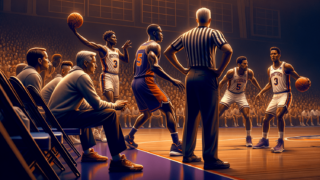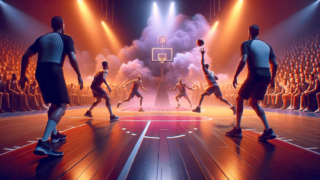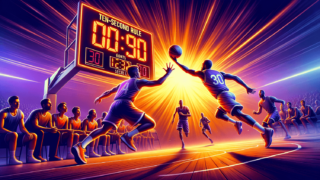
Charging vs. Blocking in Basketball: Understanding the Difference
Written by: Basketball Universe
Last updated:

In the fast-paced world of basketball, two distinct set of terms often send spectators and players alike into heated debates: charging and blocking. Both types of fouls have significant implications on gameplay, yet they might seem mystifying and hard to distinguish, especially for new enthusiasts. Join us as we unravel these complexities by diving into the exhilarating world of charging vs. blocking in basketball. We’ll help you sharpen your understanding and knowledge of these fouls so that you’ll soon become the go-to basketball genius in your group. So strap in, grab your notepad, and let’s delve into this energetic dance of offensive and defensive maneuvers!
Charging vs. Blocking in Basketball: Understanding the Difference
In basketball, charging and blocking are opposite types of fouls involving contact between an offensive player (usually with the ball) and a defensive player. A charging foul occurs when the offensive player initiates contact by running or pushing into the opponent who has already established a legal guarding position. In contrast, a blocking foul takes place when the defensive player illegally impedes the progress of the offensive player by not establishing their position early enough or moving into their path. Consequently, the key difference between these fouls lies in the players’ timing and positioning during game-play.
Mastering the Art of Legal Guarding
To fully comprehend the difference between charging and blocking fouls, it is crucial to grasp the concept of legal guarding. The basketball rules define a legally guarded position as one where the defender is firmly planted on both feet with their torso facing the offensive player. Establishing a proper legal guarding position is the cornerstone upon which any solid defense is built.
Fundamentals of Legal Guarding
Here are some key aspects of successfully establishing a legally guarded position:
- Planting both feet firmly: To establish a legal guarding position, the defender must have both feet on the floor before the contact with the offensive player occurs.
- Facing the opponent: The defender’s torso must face the offensive player for the guarding position to be considered legal.
- Maintaining a stance: The defender may not lunge at the offensive player or move sideways into their path after making contact.
- Respecting the boundaries: While guarding, defenders should remember to abide by the three-foot (90cm) restricted area around the basket as a no-charge zone.
Charging Foul: When the Offense Goes Too Far
Charging occurs when the offensive player initiates contact with a defender who has already established a legal guarding position. Analyzing charging fouls can be tricky, but understanding the fundamentals can help make these calls less perplexing.
Essential Elements of a Charging Foul
Make sure to keep an eye on these elements when identifying a charging foul:
- Legal guarding position: The defender must be in a legally guarded position to draw a charging foul.
- Contact initiation: The offensive player with the ball is the one who initiates the contact.
- Forbidden moves: A charging foul may also be called if the offensive player uses their arm, shoulder, hip, leg, or knee to forcefully create extra space against a legally guarded defender.
Common Charging Foul Misconceptions
It’s important to dispel common charging foul misconceptions to obtain a deeper understanding:
- Falling defender: Just because the defender falls does not make it a charging foul. They must have established a legal guarding position before contact.
- Ball possession: Contrary to popular belief, charging fouls can occur even when the offensive player doesn’t have the ball in their hands.
- Vertical space: A legally guarded defender still has the right to vertical space, meaning that an offensive player cannot simply jump over the defender and initiate contact without consequences.
Blocking Foul: Defending beyond the Limit
A blocking foul occurs when a defender breaks the rules of legal guarding, impeding the offensive player’s progress or movement during a game. This can happen when the defender moves into the path of the offensive player without having enough time to establish a legal guarding position, or when they continue moving laterally after contact has been made.
Important Details for Identifying a Blocking Foul
To help you assess whether or not a foul is blocking, consider these specifics:
- Defender’s feet: If the defender’s feet are still moving when contact is made, it’s highly likely a blocking foul.
- Positioning: If the defender is not properly facing the offensive player or does not allow the offensive player adequate room, a blocking foul might be called.
- No-contact bumping: Even when contact is minimal, if the defender is moving laterally and a collision occurs, a blocking foul can be called.
Common Blocking Foul Myths
Let’s debunk some common myths surrounding blocking fouls for a clearer understanding:
- Intruding the cylinder: The myth that a blocking foul is called solely when a defender intrudes on the offensive player’s imaginary “cylinder” of space is inaccurate because the defender can legally establish a guarding position prior to initiating contact.
- The Charge-Block continuum: Contrary to popular belief, there is no such thing as a “50/50” or “in-between” charge-blocking foul. At any given time, it is either a charge or a block. While close calls may be challenging to identify, they cannot be classified as a blend of both.
Impact of Charging and Blocking Fouls on the Game
Charging and blocking fouls have significant ramifications on game dynamics, team strategy, and individual player performance. It’s essential to understand these impacts to comprehend the importance of grasping the difference between these two fouls.
Team Fouls and Penalty Situations
Both fouls contribute to a team’s total number of fouls. Teams that accumulate a certain number of fouls (depending on league rules) in a period or half may be subject to penalty situations. Going over the foul limit results in the opposing team shooting free throws on each subsequent foul.
Player Foul Trouble
Additionally, players who commit charging or blocking fouls face the risk of entering “foul trouble.” Consistently racking up fouls can lead to increased scrutiny from opponents, jeopardize a player’s game minutes due to caution, and, worst-case scenario, disqualify a player from the game after reaching their maximum permitted fouls.
Shifts in Momentum
Charging and blocking foul calls can have a profound impact on on-court momentum. A well-executed defensive play can uplift a team’s morale and energy, whereas a missed call or an unwanted foul can lead to frustration, deflation, or lack of focus.
How Players and Coaches Can Leverage Charging and Blocking Fouls
As a basketball aficionado, it’s essential to learn how players and coaches can use the knowledge of these fouls to improve their own game and better strategize their approaches.
Taking Charges Strategically
Players who master the art of legally drawing charges can become a valuable asset to their team. Successfully executed charges can lead to crucial turnovers and shift game momentum in favor of the defending team. It is crucial, however, for players to practice this skill diligently, as improperly taking charges may result in injury or excessive fouls.
Avoiding Foul Trouble
Defensive players should constantly assess their foul situation and adapt accordingly. For instance, a player in foul trouble may need to defend more conservatively to limit the risk of being disqualified. Developing a deeper understanding of what constitutes charging and blocking fouls can help players make more informed decisions on whether to attempt risky defensive maneuvers.
Using Charges and Blocks for Offensive Advantage
Offensive players can also benefit from knowing the intricacies of charges and blocks. For instance, a skilled offensive player can target defenders prone to committing blocking fouls or quickly change direction against overly aggressive defenders to draw charges.
Coaching and Training Drills
Coaches have the responsibility to ingrain proper charging and blocking foul principles in their players. Incorporating training drills that practice legal guarding, taking charges, and avoiding blocking fouls can help fine-tune a player’s defensive instincts and refine their overall skills.
Throughout this comprehensive exploration of charging and blocking fouls in basketball, we’ve examined the individual characteristics that separate these two violations, dispelled myths and misconceptions, and offered insights into the broader implications for players and teams. This knowledge equips basketball enthusiasts, players, and coaches with the necessary tools to approach games with a strategic advantage and a newfound appreciation for the defensive intricacies in the great sport of basketball.
Referee’s Role in Charging and Blocking Fouls
A referee’s ability to identify and call charging and blocking fouls accurately plays a major role in maintaining a fair game. It’s vital for referees to develop expertise in distinguishing between the two types of fouls to ensure consistent and impartial decision-making during fast-paced game situations.
How Referees Make the Call
Referees make decisions on charging and blocking fouls based on their observations of defensive players’ positioning, body movement, and orientation, as well as the contact initiated by offensive players. They must pay attention to the feet and torso of both players when making their call.
Collaborating with Fellow Officials
Referees must also maintain continuous communication and collaboration with their fellow officials, especially during high-stakes situations where multiple perspectives and interpretations of events can occur. Through teamwork, referees ensure that their decisions are more accurate and consistent.
The Role of Video Replay in Charging and Blocking Foul Decisions
As basketball evolves and embraces technology, the use of video replays for critical foul decisions is increasingly becoming an integral part of the game. Video replays can provide additional clarity, enabling officials to make more accurate and fair decisions in high-stakes moments.
Instant Replay Systems
Instant replay systems, such as the NBA’s Replay Center, allow referees to review crucial game moments from multiple angles in slow motion. This helps them make informed decisions on whether a foul should be classified as blocking or charging, and even validate events that led to the potential foul – for instance, a foot on the three-point line, or possession of the ball.
The Impact of Video Replay
While video replay offers the potential for increased accuracy in referee decisions, it also sparks debates around the balance between human judgment and technology’s role in sports. Some argue that relying on video replay can take away from the authenticity of the game, as it may disrupt the natural flow or lead to excessive stoppages. In contrast, others state that technology can minimize unfair advantages and ensure a more impartial playing field.
Putting Charging and Blocking Fouls into Practice
Understanding charging and blocking fouls is one thing, but implementing this knowledge into your game or viewing experience is another. Practice and awareness will help you hone your charges and blocks discernment and make the best decisions on the court.
Practicing Defensive Movements
Players can benefit from defensive drills that focus on proper footwork, body positioning, and anticipation. These exercises will help players internalize the rules surrounding charges and blocks, becoming more natural and efficient in reacting to offensive plays.
Analyzing Game Footage
For both players and fans, analyzing game footage of charging and blocking fouls is an excellent way to sharpen your understanding of these complex situations. Observing how different players and referees respond to charging and blocking scenarios will help you comprehend the nuances of these calls and their impact on the game.
With this additional information and thorough practice, you should emerge from this exploration of charging and blocking fouls in basketball with a comprehensive understanding of the principles, techniques, and applications. Whether you’re a player, coach, referee, or passionate fan, this deeper knowledge will enable you to experience the game with newfound clarity and insight.
FAQs on Charging and Blocking in Basketball
Here is a compilation of frequently asked questions about charging and blocking fouls in basketball, designed to clarify and provide quick insights into these intriguing game aspects for enthusiasts and players alike.
1. Can a player take a charge while inside the restricted area?
No, a player cannot draw a charge while inside the restricted area, which is a three-foot (90cm) arc around the basket. If a defensive player is within this zone while trying to take a charge, officials will typically call a blocking foul.
2. Do offensive and defensive players have equal rights to a specific spot on the floor?
Yes, both offensive and defensive players have equal rights to establish their position on the court, as long as they reach that position legally and prior to any contact.
3. Can a charging foul be called on a player without the ball?
Yes, a charging foul can be called on an offensive player without the ball if they initiate contact with a legally established defender, especially when setting a screen or attempting to clear a path for a teammate.
4. Can a defensive player draw a charge if their feet are in the air while in the legal guarding position?
No, a defensive player cannot draw a charge if their feet are in the air. They must have both feet firmly planted on the ground to establish a legal guarding position and draw a charging foul.
5. Can there be a blocking foul if there is minimal contact between the players?
Yes, a blocking foul can be called even if there is minimal contact between the players. The key factor is whether the defender illegally impeded the offensive player’s path by not establishing a legal guarding position prior to initiating contact.
6. Is it a charging foul if the defender falls to the ground after contact?
Not necessarily. While the referee may call a charging foul in such a situation, the key factor is whether the defender established their legal guarding position before the contact occurred, rather than the defender’s fall.
7. How do league-specific rules impact charging and blocking fouls?
While the fundamental concepts of charging and blocking are consistent throughout basketball, league-specific rules may impact some aspects, such as team foul limits and the size of the restricted area. It’s essential to familiarize yourself with the specific rules of your league to ensure accurate understanding and application of these fouls.
8. How can offensive players avoid charging fouls while driving to the basket?
Offensive players must develop spatial awareness and quick decision-making to avoid charging fouls. By reading defenders’ movements, predicting their positioning, and adapting their path to the basket, offensive players can minimize the likelihood of committing charging fouls.
9. How can players practice taking charges?
Players can practice taking charges by simulating game scenarios with teammates or organizing drills focused on establishing legal guarding positions, understanding contact initiation, and adapting their body to absorb the impact when taking a charge. It’s important to learn proper falling techniques to minimize the risk of injury while practicing.
10. What is the penalty for a charging or blocking foul?
Penalties for charging and blocking fouls include awarding the opposing team possession of the ball (for offensive fouls) and potentially free throw attempts (for defensive fouls). Both fouls also contribute to the player and team foul count, which can impact a game’s dynamic and strategy.
Featured Posts
- No pillar pages found.





